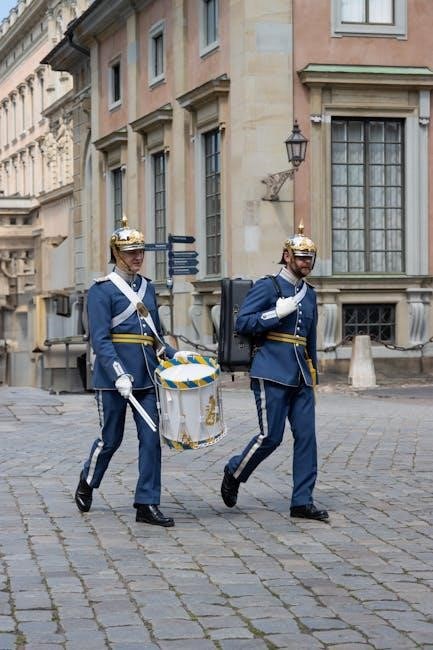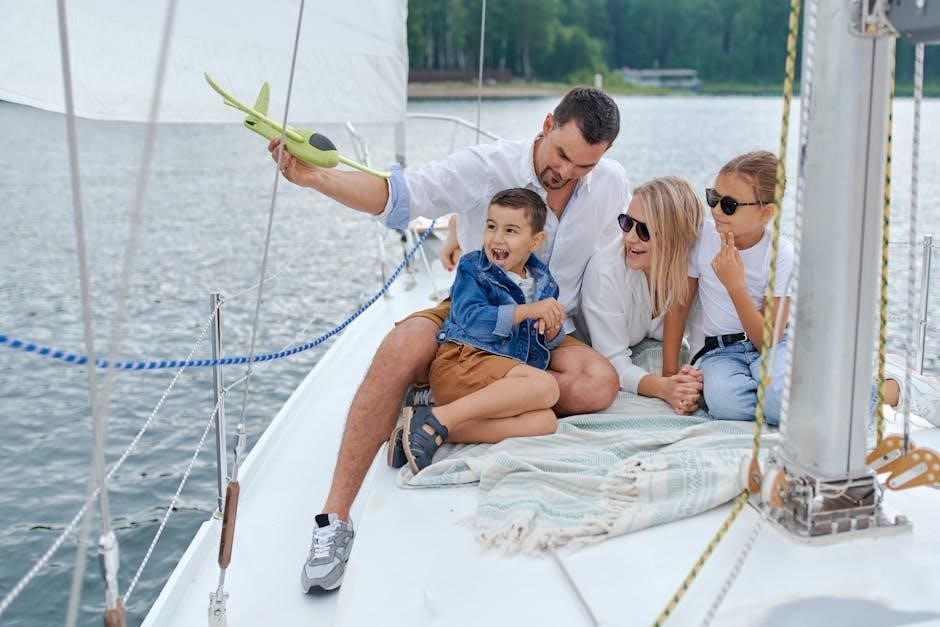The Myott Developmental Milestones Guide is a free, comprehensive PDF resource designed to track a child’s growth from birth to 21 years, covering key developmental domains.
Overview of the Guide
The Myott Developmental Milestones Guide is a comprehensive, evidence-based resource designed to support parents, caregivers, and professionals in tracking a child’s developmental progress. Available as a free PDF download, it covers key milestones from birth to 21 years, organized into five domains: physical, social-emotional, communication, cognitive, and approaches to learning. The guide provides detailed, age-specific checklists and charts, making it easy to monitor progress and identify potential delays. Its user-friendly format ensures accessibility for diverse users, while its cultural adaptability allows for application across various settings. By offering a structured framework, the guide empowers individuals to support holistic development, fostering early intervention and personalized growth strategies. This resource is invaluable for promoting healthy development and ensuring children reach their full potential.
Importance of Tracking Developmental Milestones

Tracking developmental milestones is essential for ensuring a child’s healthy growth and identifying potential delays early. It provides insights into physical, social-emotional, communication, cognitive, and learning skills, enabling timely interventions. By monitoring progress, parents and caregivers can address concerns promptly, fostering a nurturing environment tailored to the child’s needs. Early detection of delays allows for targeted support, improving long-term outcomes. Professionals, such as pediatric specialists and occupational therapists, use this data for assessments and goal setting. Tracking milestones also empowers parents to create supportive environments, promoting holistic development. This proactive approach ensures children receive the necessary tools to thrive, fostering a strong foundation for lifelong well-being and success.

Key Features of the Myott Developmental Milestones Guide

The guide offers a comprehensive framework, user-friendly design, evidence-based approach, and cultural adaptability. It provides detailed milestones, checklists, and is available as a free PDF for easy access.
Comprehensive Framework
The Myott Developmental Milestones Guide provides a detailed and organized structure for tracking a child’s development across five key domains: physical, social-emotional, communication, cognitive, and approaches to learning. This framework ensures a holistic approach to understanding growth, with age-specific milestones from birth to 21 years. Each domain is meticulously outlined, offering clear benchmarks for parents and professionals to monitor progress effectively. The guide’s comprehensive nature allows users to identify typical developmental patterns and detect potential delays early, enabling timely interventions. By covering all aspects of development, it serves as an essential tool for fostering a child’s overall growth and well-being.
User-Friendly Design
The Myott Developmental Milestones Guide is designed with accessibility and ease of use in mind, ensuring that parents, caregivers, and professionals can navigate its content effortlessly. Available as a free PDF download, the guide features a clear and intuitive structure, with age-specific milestones organized into easy-to-follow sections. The inclusion of detailed checklists and charts allows users to track progress quickly and efficiently. Its user-friendly format ensures that even those without prior experience can utilize the guide effectively. The design is optimized for accessibility across devices, making it a versatile tool for monitoring developmental milestones in various settings. This approach empowers users to focus on supporting a child’s growth without being hindered by complex layouts or confusing terminology.
Evidence-Based Approach
The Myott Developmental Milestones Guide is rooted in a robust evidence-based approach, ensuring reliability and accuracy in tracking a child’s developmental progress. Compiled from over twenty expert resources, the guide synthesizes leading research to provide comprehensive and age-specific milestones. This ensures that the information is grounded in scientific evidence and widely accepted developmental standards. The guide’s framework is designed to reflect the latest understanding of child development, making it a trusted tool for parents, caregivers, and professionals. By relying on expert data, the Myott guide offers a credible and authoritative resource for monitoring growth and identifying potential delays. Its evidence-based foundation supports early intervention and informed decision-making, fostering a child’s optimal development across all domains.
Cultural Adaptability
The Myott Developmental Milestones Guide is designed with cultural adaptability in mind, ensuring its relevance across diverse backgrounds and environments. Recognizing that developmental patterns may vary due to cultural influences, the guide provides a flexible framework that respects individual differences. Its universal milestones are presented in a way that accommodates varying cultural practices and values, making it accessible to a global audience. The guide avoids imposing a one-size-fits-all approach, instead offering a sensitive and inclusive tool for parents and professionals worldwide. This adaptability ensures that the guide remains effective in different cultural contexts, fostering holistic development while respecting the unique traditions and beliefs of each family. Its accessibility across devices further enhances its usability for diverse users, promoting equitable support for children’s growth regardless of cultural background.
Developmental Domains Covered
The guide covers five key domains: physical/motor skills, social-emotional growth, communication/language, cognitive development, and approaches to learning, ensuring a holistic view of a child’s development.

Physical and Motor Skills
The Myott Developmental Milestones Guide provides a detailed framework for tracking physical and motor skills, from infancy to early adulthood. It outlines key milestones such as sitting, walking, and fine motor abilities like grasping and writing. The guide categorizes these skills into age-specific ranges, offering clear benchmarks for parents and professionals. By including checklists and charts, it simplifies the process of monitoring progress in locomotion, daily living activities, and coordination. This section is particularly valuable for occupational therapists and caregivers seeking to support a child’s physical growth effectively. The free PDF download ensures accessibility for all users, making it easier to track and foster a child’s physical development from birth to 21 years.
Social-Emotional Growth
The Myott Developmental Milestones Guide provides a detailed framework for tracking social-emotional growth, offering clear benchmarks for understanding a child’s evolving self-awareness, empathy, and interpersonal skills. It outlines how children develop emotional regulation, form relationships, and demonstrate cooperation. The guide includes age-specific checklists to track progress in social interactions and emotional intelligence. This section is particularly useful for identifying typical behaviors and supporting children in building strong social-emotional foundations. With its detailed yet accessible framework, it empowers caregivers and professionals to foster healthy emotional development from early childhood through adolescence, ensuring a strong foundation for lifelong well-being. The guide’s structured approach helps identify developmental stages accurately, offering a clear roadmap for growth and support.
Communication and Language
The Myott Developmental Milestones Guide provides a detailed framework for tracking communication and language development, offering age-specific milestones from birth to 21 years. It includes checklists for verbal and non-verbal skills, such as babbling, first words, and complex sentence formation. The guide helps parents and professionals identify typical language development patterns and potential delays. By categorizing milestones into clear age ranges, it supports early identification of speech and language challenges, enabling timely interventions. This section is invaluable for fostering strong communication skills and promoting lifelong language proficiency. The guide’s structured approach ensures comprehensive tracking, making it an essential tool for caregivers and educators to support a child’s linguistic growth effectively.
Cognitive Development
The Myott Developmental Milestones Guide outlines key cognitive development milestones, highlighting how children progress from basic problem-solving to complex thinking. It tracks memory, understanding cause-and-effect, and logical reasoning. The guide provides age-specific checklists, helping parents and professionals monitor cognitive growth from infancy to 21 years. By identifying typical milestones, users can detect potential delays and support educational and intellectual development. This section emphasizes the importance of cognitive skills in lifelong learning, offering a clear framework for fostering intellectual growth and addressing developmental challenges early. The guide’s detailed approach makes it an invaluable resource for caregivers and educators alike, ensuring comprehensive support for a child’s cognitive journey.
Approaches to Learning
The Myott Developmental Milestones Guide emphasizes the importance of tracking a child’s approaches to learning, such as curiosity, persistence, and problem-solving skills. This section outlines how children develop a love for learning and engage with their environment. By monitoring milestones like initiation, creativity, and critical thinking, parents and educators can identify readiness for school and foster a strong foundation for academic success. The guide provides detailed checklists to assess these skills, ensuring early intervention and support for children who may need additional guidance in developing these essential learning behaviors. This section is particularly valuable for promoting a child’s natural curiosity and fostering a lifelong love of learning, making it an indispensable tool for caregivers and educators alike.

Age-Specific Milestones
The Myott Guide provides detailed milestones across four age ranges: 0-12 months, 12-36 months, 3-5 years, and 5-21 years, offering clear benchmarks for tracking developmental progress effectively.
Infancy (0-12 Months)
The Myott Guide details infant milestones from 0-12 months, focusing on physical, social-emotional, and communication skills. It includes checklists for tracking achievements like head control, rolling, sitting, and crawling. Language development milestones, such as cooing, babbling, and saying first words, are also highlighted. Social-emotional growth is addressed, with indicators like responding to sounds, smiling, and showing affection. The guide provides age-specific charts to monitor progress, ensuring early identification of typical development patterns. This section emphasizes the importance of these early milestones in laying a strong foundation for future growth. By offering clear, detailed benchmarks, the Myott Guide empowers parents and professionals to support infants during this critical phase of development.
Toddler Years (12-36 Months)

The Myott Guide outlines key milestones for toddlers aged 12-36 months, focusing on motor skills, language, and social-emotional growth. Physical development includes walking, running, climbing, and improving coordination. Language milestones involve pointing to body parts, saying simple words, and combining two words by 24 months. Social-emotional growth is marked by showing affection, interacting with peers, and demonstrating curiosity. The guide provides detailed checklists to track these achievements, ensuring parents and professionals can monitor progress effectively. This section emphasizes the importance of early identification of developmental patterns during this critical growth phase. By offering clear, age-specific benchmarks, the Myott Guide supports caregivers in fostering a toddler’s physical, emotional, and cognitive development, ensuring a strong foundation for future growth.
Early Childhood (3-5 Years)
The Myott Guide details developmental milestones for children aged 3-5 years, focusing on physical, language, social-emotional, and cognitive growth. Physically, children refine skills like running, jumping, and using utensils. Language development includes forming complex sentences, identifying colors, and engaging in conversations. Social-emotional growth is marked by cooperation, empathy, and self-awareness. Cognitive abilities expand with problem-solving, memory, and understanding cause-and-effect relationships. The guide provides detailed checklists to track these milestones, helping parents and professionals monitor progress. This section highlights the importance of fostering independence, creativity, and social interactions during early childhood. By offering clear, age-specific benchmarks, the Myott Guide supports caregivers in identifying typical development patterns and addressing any delays, ensuring a strong foundation for future growth and learning.
Late Childhood and Adolescence (5-21 Years)
The Myott Guide provides detailed milestones for late childhood and adolescence, spanning ages 5 to 21. This section focuses on refining physical skills, such as sports and fine motor tasks, while emphasizing social-emotional growth, including self-identity, peer relationships, and emotional regulation. Communication skills expand to include complex language and interpersonal interactions. Cognitive development highlights problem-solving, abstract thinking, and academic readiness. The guide also addresses approaches to learning, such as critical thinking and self-directed learning. By offering age-specific checklists, it helps parents and professionals monitor progress and identify potential delays. This section underscores the importance of fostering independence, resilience, and lifelong learning skills during these formative years, ensuring a smooth transition into adulthood.
Practical Applications of the Guide
The Myott Guide offers tools for monitoring progress, detecting delays early, and setting developmental goals, empowering parents and professionals to support children’s growth effectively.
Monitoring Developmental Progress

The Myott Developmental Milestones Guide provides detailed checklists and age-specific milestones, enabling parents and professionals to track a child’s progress across five developmental domains. By offering clear benchmarks, the guide helps identify achievements and delays, ensuring timely support. Its user-friendly format allows for regular monitoring, fostering a proactive approach to child development. The guide’s structured framework empowers users to observe growth, address concerns, and adapt strategies as needed. This tool is particularly valuable for early intervention, as it promotes a comprehensive understanding of a child’s developmental journey. With its accessible design, the Myott Guide supports consistent and effective monitoring, helping to create a nurturing environment for holistic growth.

Early Detection of Delays
The Myott Developmental Milestones Guide is an invaluable tool for early detection of developmental delays, providing clear, age-specific benchmarks across five key domains. By tracking milestones such as physical skills, language development, and social-emotional growth, parents and professionals can quickly identify areas where a child may need additional support. The guide’s detailed checklists and evidence-based framework enable users to recognize potential delays early, allowing for timely interventions. This proactive approach ensures that children receive the necessary resources and therapies to address challenges effectively. Early detection is crucial for improving long-term outcomes, and the Myott Guide empowers caregivers and professionals to take action promptly, fostering a child’s optimal development and well-being.
Setting Developmental Goals
The Myott Developmental Milestones Guide provides a structured framework for setting clear, achievable developmental goals for children. By identifying specific milestones across five domains, parents and professionals can create personalized plans tailored to a child’s unique needs. The guide’s detailed checklists and age-specific benchmarks enable users to set realistic objectives, fostering steady progress and celebrating achievements. This goal-setting process encourages collaboration between caregivers and professionals, ensuring a cohesive approach to supporting a child’s growth. By aligning goals with developmental expectations, the Myott Guide helps children build foundational skills, address challenges, and thrive. Its practical tools empower users to create a supportive environment, promoting holistic development and helping children reach their full potential.

Benefits for Users
The Myott Guide empowers parents and caregivers with insights to support growth, aids professionals in assessments, and promotes holistic development, ensuring a well-rounded approach to child development.
Empowerment for Parents and Caregivers
The Myott Developmental Milestones Guide equips parents and caregivers with essential tools to monitor and support a child’s growth effectively. By providing clear, age-specific milestones across five developmental domains, it enables families to track progress with confidence. The guide’s user-friendly design and detailed checklists make it easy to identify achievements and address concerns early, fostering a nurturing environment. Parents gain valuable insights to promote healthy development, while caregivers can use the guide to create personalized plans tailored to a child’s needs. This empowerment ensures that families are proactive in supporting their child’s unique journey, from infancy through adolescence. The free PDF format makes it accessible to everyone, offering a practical and comprehensive resource for fostering holistic growth and addressing developmental challenges promptly.
Valuable Tool for Professionals
The Myott Developmental Milestones Guide is an indispensable resource for professionals, offering a comprehensive framework to assess and support child development. Pediatric specialists, occupational therapists, and educators can utilize its detailed milestones and checklists to identify typical developmental patterns and detect potential delays. The guide’s evidence-based approach ensures reliability, while its clear structure simplifies goal setting and intervention planning. Professionals appreciate the age-specific breakdown, which aids in monitoring progress across five domains: physical, social-emotional, communication, cognitive, and approaches to learning. The free PDF format makes it easily accessible, allowing professionals to collaborate effectively with families and provide tailored support. This tool enhances assessments, screenings, and developmental planning, making it a cornerstone for promoting holistic growth in children.
Promoting Holistic Development
The Myott Developmental Milestones Guide is designed to foster holistic development by addressing five key domains: physical, social-emotional, communication, cognitive, and approaches to learning. This comprehensive approach ensures that no aspect of a child’s growth is overlooked, providing a balanced perspective on their overall development. By tracking milestones across these domains, parents and professionals can identify areas where support is needed, enabling early intervention and tailored strategies. The guide’s detailed checklists and age-specific frameworks make it easier to monitor progress and address challenges, promoting a nurturing environment that encourages healthy growth. This holistic focus empowers caregivers to support every child’s unique journey, ensuring they thrive emotionally, intellectually, and physically. The guide’s emphasis on interconnected development helps create a strong foundation for lifelong well-being and success.
Conclusion
The Myott Developmental Milestones Guide is a valuable, free resource empowering parents and professionals to track and support a child’s growth effectively from birth to 21 years.
Final Thoughts on the Myott Guide
The Myott Developmental Milestones Guide is an invaluable, free resource that empowers parents, caregivers, and professionals to support a child’s holistic development. Its comprehensive framework, spanning birth to 21 years, provides clear, age-specific milestones across five key domains. By offering detailed checklists and evidence-based insights, the guide enables early detection of delays and fosters timely interventions. Its user-friendly design and cultural adaptability make it accessible to diverse users, ensuring that every child’s unique journey is supported effectively. Whether for monitoring progress, setting developmental goals, or promoting collaboration between families and professionals, the Myott Guide stands out as an essential tool for nurturing growth and ensuring children reach their full potential.

































































